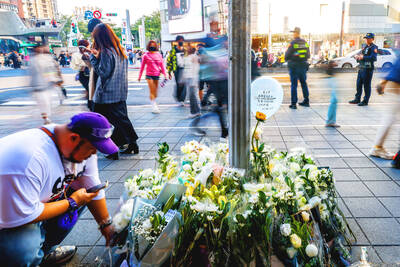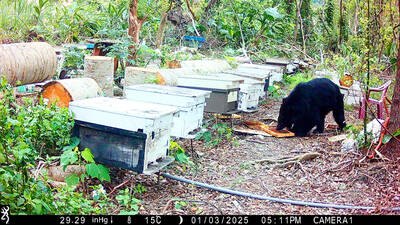The Taiwan Railways Administration (TRA) is next year to start changing some of its antiquated power facilities, with the cost of the four-year project expected to top NT$8 billion (US$280.30 million).
While the launch on Dec. 20 of electrified train services on the South Link Line — which was the nation’s last unelectrified railway line — marked a significant milestone, the agency yesterday said that some of its power facilities have reached the age of retirement after having been used for more than four decades.
The agency has been gradually retiring some of the high-risk power system facilities since 2015, it said.
As of the end of this year, it has changed 1,260km of main overhead wires, TRA electricity section chief Cheng Chih-ming (鄭志銘) said, adding that the new wires have increased structural tension by 22 percent and reduced the number of incidents caused by broken overhead wires.
The agency also increased the capacity of the transformers in nine of the substations along the line from 15 megavolt-amperes to 25 megavolt-amperes, Cheng said.
Workers’ ability to repair and maintain the wires have vastly improved through the use of 17 newly purchased overhead line maintenance vehicles, he added.
Cheng said the agency would spend NT$8 billion in the next four years to replace some of the critical infrastructure in its power system.
Traditional wires in the underground tunnel connecting New Taipei City’s Sijhih (汐止) and Fuchou (浮洲) railway stations — which stretches a total of 52km — would be replaced with conductor rail wires, he said.
The agency would also purchase two high-speed overhead line inspection vehicles, which can quickly convert collected information into quantitative data, he said.
“Our long-term goal is to develop an Internet-of-Things system to manage the facilities related to the railway system,” Cheng said. “Using a smart system would allow us to quickly locate a malfunctioning current transformer or a protective relay.”
“This would reduce our maintenance costs and enable us to run a safer and reliable train service,” he added.
Maintenance workers in the agency would also undergo training focused on life-cycle management systems for railway facilities, in which they would learn to better identify facilities that need replacement and propose changes, Cheng said.

SHIPS, TRAINS AND AUTOMOBILES: The ministry has announced changes to varied transportation industries taking effect soon, with a number of effects for passengers Beginning next month, the post office is canceling signature upon delivery and written inquiry services for international registered small packets in accordance with the new policy of the Universal Postal Union, the Ministry of Transportation and Communications said yesterday. The new policy does not apply to packets that are to be delivered to China, the ministry said. Senders of international registered small packets would receive a NT$10 rebate on postage if the packets are sent from Jan. 1 to March 31, it added. The ministry said that three other policies are also scheduled to take effect next month. International cruise ship operators

HORROR STORIES: One victim recounted not realizing they had been stabbed and seeing people bleeding, while another recalled breaking down in tears after fleeing A man on Friday died after he tried to fight the knife-wielding suspect who went on a stabbing spree near two of Taipei’s busiest metro stations, Taipei Mayor Chiang Wan-an (蔣萬安) said. The 57-year-old man, identified by his family name, Yu (余), encountered the suspect at Exit M7 of Taipei Main Station and immediately tried to stop him, but was fatally wounded and later died, Chiang said, calling the incident “heartbreaking.” Yu’s family would receive at least NT$5 million (US$158,584) in compensation through the Taipei Rapid Transit Corp’s (TRTC) insurance coverage, he said after convening an emergency security response meeting yesterday morning. National

PLANNED: The suspect visited the crime scene before the killings, seeking information on how to access the roof, and had extensively researched a 2014 stabbing incident The suspect in a stabbing attack that killed three people and injured 11 in Taipei on Friday had planned the assault and set fires at other locations earlier in the day, law enforcement officials said yesterday. National Police Agency (NPA) Director-General Chang Jung-hsin (張榮興) said the suspect, a 27-year-old man named Chang Wen (張文), began the attacks at 3:40pm, first setting off smoke bombs on a road, damaging cars and motorbikes. Earlier, Chang Wen set fire to a rental room where he was staying on Gongyuan Road in Zhongzheng District (中正), Chang Jung-hsin said. The suspect later threw smoke grenades near two exits

The Forestry and Nature Conservation Agency yesterday launched a gift box to market honey “certified by a Formosan black bear” in appreciation of a beekeeper’s amicable interaction with a honey-thieving bear. Beekeeper Chih Ming-chen (池明鎮) in January inspected his bee farm in Hualien County’s Jhuosi Township (卓溪) and found that more than 20 beehives had been destroyed and many hives were eaten, with bear droppings and paw prints near the destroyed hives, the agency said. Chih returned to the farm to move the remaining beehives away that evening when he encountered a Formosan black bear only 20m away, the agency said. The bear